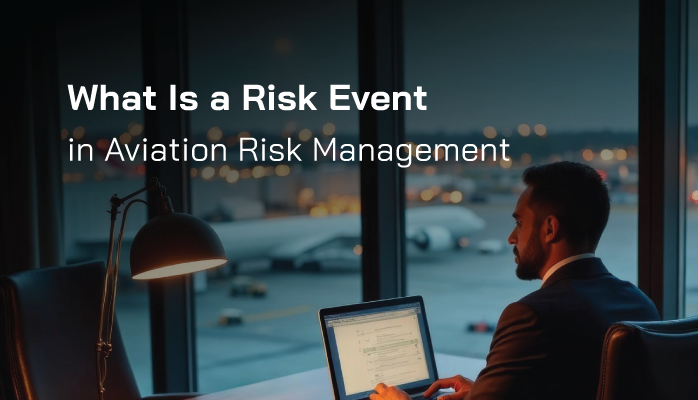Difference Between Risk and Risk Event

Last year we released a Hazard and Risk Competency Quiz, which deals a lot with the concept of Risk Events. Overall the assessment – which was purposefully very difficult – was very successful.
We received a lot of feedback about Risk Events, and for the most part aviation safety managers fall into 3 categories concerning Risk Events. If you are familiar with the assessment, which category do you fall into?
- Unfamiliar with “Risk Event” but thought it was interesting;
- Found the concept and use of “Risk Event” very helpful in risk management activities; or
- Disagreed with the use of “risk”, citing traditional definitions of risk as an argument.
Related Risk Articles in Aviation SMS
- What Is Process for Risk Analysis in Aviation SMS
- What Is a Risk Matrix and Risk Assessment in Aviation SMS
- The 5 Risk Mitigation Strategies in Aviation SMS
What Is Risk in Aviation SMS
“Risk Event” and “risk” in general are not the same thing. Risk is:
- A conceptual element of aviation safety management;
- Has an undeniable subjective element;
- Used to understand exposure through likelihood and severity of the situation; and
- Is not associated with a specific part of the flow of events in a safety issue.
What Is a Risk Event in Aviation SMS
Conversely, a Risk Event is:
- Defined by some kind of action, rather than a concept;
- Is partially subjective;
- Is a specific, identifiable part of the flow of events in a safety issue;
- Is the middle point between proactive actions/controls and reactive actions/controls; and
- Used to understand where in a safety event the failure occurred.
The practical difference between risk and Risk Events is that Risk Event has a specific use in risk management activities. Risk does not have a specific use, but is something that every aviation SMS implementation needs to define, as it will broadly influence all risk management activities.
What Is a Risk Event in Aviation Risk Management

A Risk Event in aviation SMS can be summarized by the following points:
- It is the point in the flow of safety events at which, “safety control is compromised/lost”;
- Is the point after which employees need to react in order to regain safety control;
- Is a single event (there is only one Risk Event per safety issue);
- Arises from a single hazard or a combination of hazards which become dangerous;
- Is the middle point in-between proactive risk management and reactive risk management; and
- Is synonymous with the Top Event used in the bowtie analysis.
With a little practice, it’s easy to become familiar with Risk Events. As said, there is some subjectivity involved, as “the point at which safety control is lost” may appear slightly different to different safety professionals.
Surprisingly often, however, the Risk Event will be ubiquitously agreed upon.
Related Risk Articles in Aviation SMS
- Difference Between Hazards, Risks & Control Measures in Aviation SMS
- 4 Pillars | What Is Risk Assessment in Aviation SMS
- Types of Operational Risk for Airline SMS
Examples of Risk Events
A Risk Event is something you would identify during risk analysis. Some good examples of “Risk Events” are:
- Flying too close to a flock of birds (however you define “close” to be), because pilots need to react immediately;
- Crossing the hold short line on a runway (runway incursion), as pilots will need to take immediate action to get off of the runway;
- Losing servers (internet) in an airport; or
- Losing control of a ground operations vehicle.
You will notice that a Risk Event is not when an undesirable event happens, such as hitting the birds, rolling the ground ops vehicle, or a near miss on the runway.
- Undesirable events should be associated with consequences and impacts that arise from a Risk Event
What Is the Flow of Safety Events?
If the concept and application of “flow of safety events” are not clear, it’s hard to understand what a Risk Event is and why it is extremely useful. Below is a graphic that describes the origin and conclusion of a safety event.

Incidentally, the purpose of bowtie analysis is to capture the flow of safety events, such as shown above. Whereas a bowtie commonly lists a “Top Event”, a Risk Event might be more to the point.

In any case, Top Events are isolated to being used in the bowtie analysis, whereas a risk event can be used in any risk management activity.
Related Articles on Using Bowtie Analysis in Aviation SMS
- What, Why, and How to Use Bowtie Analysis in Aviation SMS
- 6 Essential Rules for Bowtie Analysis in Aviation SMS
- 4 Best Uses of Bowtie Method in SMS Risk Management – Do You Use Them?
Why Is Risk Event Important
It’s important to understand what a Risk Event is because it gives:
- Employees a specific, tangible moment/event/action to try and avoid during operations;
- Employees an opportunity to react quickly should they recognize a risk event as it unfolds in operations;
- Managers a “waypoint” during risk analysis;
- Managers a reference point for defining proactive risk management activities and reactive risk management activities; and
- Makes separation of proactive and reactive risk controls clearer and more manageable.
The other reason Risk Events are important is that they can be used in any number of risk management activities, such as:
- In fishbone diagrams – it will be the “head” of the fish;
- In risk assessments – it will be used to assess the severity of potential impacts which arise from the risk event and the likelihood of the risk event happening in the future;
- In bowtie analysis – it will be your Top Event;
- In general risk management activities, such as defining proactive/reactive risk management operations; and
- In aviation safety training.
Final Thought: More Resources on Risk Events
Several good resources are provided regarding Risk Events. For more information, see the following resources:
- Difference between hazards, impacts, and risk (i.e., Risk Events);
- See Top Event in this article on how to perform bowtie analysis;
- See the Head in this article about how to create fishbone diagrams; and
- See the link in the button below to download the Hazard and Risk Competency Quiz - remember this test is designed to be challenging!
Last updated October 2025.







